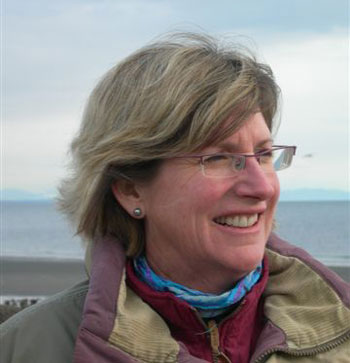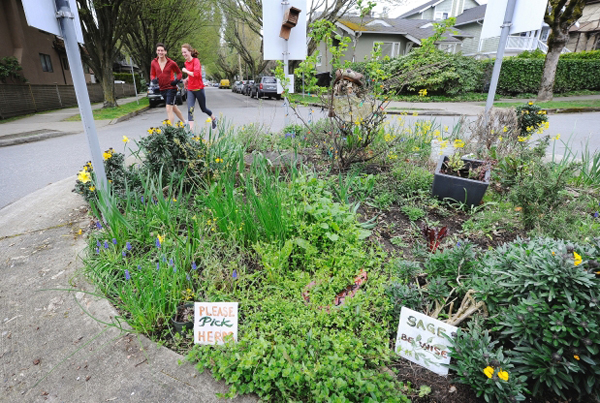News
Interview with Sandra James, International ASLA, City and Greenways Planner, City of Vancouver
 Sandra James
Sandra JamesWhat is a green street? How does Vancouver define a green street? Is this different from how other cities are defining it?
For the city of Vancouver, a green street is really a street where walking and biking is prioritized ahead of cars. In 1992, we were a bit ahead of the curve -- a group of landscape architects and people who were genuinely interested in the walking environment formed an Urban Landscape Taskforce and looked at designing a system of streets that went border to border, called "greenways." These streets have sidewalks, pedestrian ramps at each corner of the sidewalk, pedestrian activated intersection controls where needed, infiltration bulges, way finding, public plantings, benches, water fountains and public art. But, functionally, they really are called green streets in any other part of the country or in North America.
What policies needed to change to get Vancouver's green street program in place? In many cities, sustainable design practices still break lots of zoning rules. How progressive were Vancouver's rules?
One of the things that is helpful is to review your existing policy. In many cases, a policy exists. In North America, most cities' transportation plans list walking as the first priority, the second preferred mode of transportation is biking, and then cars are third.
Green streets allow us a trial location for innovative demonstration projects that could become part of the streetscape palette in the rest of the city. One interesting thing we did was "Wellness Walkways." These are connected paths around a precinct of hospitals and seniors' residences that have non-glare pavement, saw-cut sidewalk joints to make it easier for wheelchairs, transfer benches, and plantings that designed to be smelled first, seen second.
Green streets, sustainable streets or greenways are streets that are for pedestrians first and this also fits into Vancouver's transportation plan. In a lot of ways, there is existing policy, and all we need is to do is to work on that policy, and also adopt the objective of putting in greenways or green streets, to move that policy forward. It also fits well into community plans and planning, which often have policy to make the walking environment safer, greener, and more accessible. "The Blooming Boulevard" program, allowing residents to garden the area between the curb and the sidewalk in front of their residences, came out of a community planning initiative.
 Vancouver Street Garden / Vancouver Sun
Vancouver Street Garden / Vancouver Sun
Engineering, planning and landscape architecture all get a win.
Please describe community involvement in creating and maintaining Vancouver's green streets. How successful has the volunteer maintenance component of the program been?
They're really two components of public participation and community
involvement in our process. The first is the city-wide greenways of 16
routes, which are managed and taken care of by the city's money, capital
funding. For this program, we have a complete planning process that
goes out to the public. The public is invited to open houses, are given
newsletters, and are surveyed. There's information on the Internet about
the complete plan, the part we are working on now, and how people can
get involved. It's run just like any other planning process in the
city.
The second piece is the participatory piece, and that would be for
people on what we call neighborhood greenways, or neighborhood green
street connections, that are usually about 100 to 500 feet long and
connect stores, commercial buildings, or places people want to go to.
Those are maintained by neighborhood communities. A neighborhood has to
agree to want to take care of that space before it's built. It's worked
out very well. Occasionally every second or third year we'll go in to
get a haircut, or to make the space look better. But in the 11 that
we've done so far, they've become places of great pride, and the
communities do take care of them.
Planetizen noted a study that said "traffic calming measures increase nearby property values by 30 percent." Were these types of financial calculations involved in Vancouver's decision to invest in green streets?
No, they weren't. The Greenways Plan identifies the green streets as "green paths" for pedestrian and cyclists connecting people with important destinations. I don't know how you would put a value on a street that values pedestrians and bikers ahead of car traffic. One of the things we did look at is bikeways, streets where we would put bikes, and see whether there was an impact on residential value. We found that there was no negative impact.
 Vancouver Greenways / Millennium Water
Vancouver Greenways / Millennium Water
I can tell you apocryphally that I now do get calls from real estate agents asking me if I know of any houses coming up for sale along greenways. Greenways and green streets go across the city. People who use the greenway near their homes are normally the folks in the neighborhood who use them to take out baby buggies or get groceries. They know it's a safe street that has plants and some visual interest. They will meet their neighbours on a green street.
In terms of environmental benefits, how are you quantifying the climate change mitigation value of green streets? Are you looking for CO2 emission reductions that result from decreased car use? What about the inherent environmental value of the green infrastructure?
We're now starting to qualify and quantify in terms of greenhouse gases (GHGs), and in terms of the amenity that's provided both for the pedestrians and those who live along these locations. We're also looking at neighborhood development in terms of GHGs.
Our real hope is our model of a green street will be adopted by other cities, municipalities, and counties to help with their GHG emissions.
Streets, sidewalks and alleys occupy between 25 and 30 percent of urban land-- in total, a huge amount of land. How quickly do you think more sustainable green streets can be designed and installed? How can cities incentivize their growth?
Allan Jacobs, who used to be the director of planning for San Francisco, always mentions that 25 to 30 percent of a city's fabric is streets. The idea is that if you can take care of that street's urban design, you've already handled a third of the problems. In the Vancouver model, the sustainable streets or green streets are a success. They became a place where the community wants to spend time. Car traffic is diminished.
Bicyclists have access ahead of cars. Part of this has been to show by example and part of it is also been leading through policy. We have tremendous public support for the development of these green streets.
Lastly, what other cities serve as models for green street development? What street design manuals have you looked at? What cities inspire Vancouver's work?
I think every city in North America has a kernel. I think every place has something special to offer. Lots of space is starting to look homogenized, because we're using the same set of benches or receptacles as every other city. What makes a difference is a regional or local twist. For that reason, I think place-making is really important. There is a role for landscape architects in helping municipalities understand what is special about their place, and helping them interpret that through wayfinding and public art. It's time to stop thinking of our cities as one place and of nature as some place else.
I look to Seattle. I look to Portland, San Diego, Paris. Barcelona is another great walkable city. But I think we also do a lot of great work just in the kernels. I've also been in very small places that have done great jobs. Juneau is one.
Sandra James, International ASLA, is a City and Greenways Planner for the City of Vancouver. James developed the City's Blooming Boulevard program, and was involved in Citywide Greenways, Neighbourhood Greenways, and the creation of a playground and park space with Let Them Be Kids. Learn more about Vancouver's green streets. James can be reached at sandy.james@vancouver.ca
Interview conducted by Jared Green.